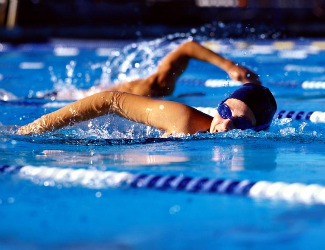Swimming in chlorinated pools can damage DNA

Swimming in indoor pools treated with chlorine can cause genotoxic effects (damage to DNA) as well as respiratory problems. This has been confirmed by a new study published in the journal Environmental Health Perspectives. The study was coordinated by researchers at Centre for the Research in Environmental Epidemiology (CREAL) and Institute of Medical Research at Hospital del Mar (IMIM), with the participation of UAB researchers.
The new study offers exhaustive details on DBPs (disinfection by-products) and on mutagenicity (capacity to cause permanent DNA mutations) gathered from water samples in two indoor pools; one disinfected with chlorine and the other with bromine. The study included information on short term changes observed in the biomarkers of genotoxicity and respiratory problems among participants using the pool treated with chlorine.
DBPs found in pools are the result of chemical reactions between water disinfectants such as chlorine and organic matter appearing naturally or introduced into the pool by swimmers through sweat, skin cells and/or urine. Previous epidemiological studies had discovered associations between exposure to disinfection by-products in potable water and the risk of bladder cancer. One of these studies in particular, coordinated by CREAL, concluded that this association was possible through dermal exposure and inhalation during showers, baths or swimming.
Evidence of genotoxic effects was observed in 49 healthy adults after swimming for 40 minutes in a chlorinated indoor pool. Specifically, researchers discovered an increase in the levels of two genotoxicity biomarkers in correlation with the concentration of the most common DBPs found in samples of exhaled air after swimming. The biomarkers which increased in levels were micronuclei in blood (indicator of DNA damage and a cancer risk predictor in healthy subjects) and urinary mutagenicity, an indicator of exposure to genotoxic agents.
Detailed measurements were also taken of the most common exhaled disinfection by-products (trihalomethanes) in the air near the pool and in air exhaled by participants before and after swimming. Biomarkers of respiratory effects were measured after swimming and only a slight increase in the CC16 protein in serum was found, which suggests an increase in the permeability of the lung epithelium.
Over 100 DBPs were identified in the pool water, some of which had never been described in pool and/or potable water treated with chlorine. In vitro assays demonstrated that pool water had similar levels of mutagenicity as potable water, although cytotoxicity levels were higher (thus able to kill cells are lower concentration levels).
In this study participants underwent a short-duration exposure (40 minutes). In view of the results Manolis Kogevinas, co-director of CREAL, affirms that "now more studies are needed on the genotoxic and respiratory effects of long-duration exposures". The study also points to the need to carry out research with pools under different maintenance and use conditions, as well as to determine any possible effects caused by the large range of compounds found in the water. The results of the study however will have to be confirmed with a larger sample of participants.
Nevertheless, CREAL's co-director remarks that "positive health effects gained by swimming could be increased by reducing the potential health risks of pool water". He goes on to say that "in no way do we want people to stop going to the pool; we are looking to promote less chemical products in the water and at the same time guarantee maximum disinfection of the pool".
In fact, reducing DBP levels can be achieved with the rigorous application of hygiene measures such as taking showers before entering the pool, using swimming caps, not urinating and correct maintenance of facilities.
In addition to researchers from CREAL and IMIM, participating in the study were researchers from UAB's Mutagenesis Group at the Department of Genetics and Microbiology, from the Spanish National Research Council (CSIC), and Barcelona's Hospital Clínic, together with researchers from Germany, The Netherlands and USA.
References
"Genotoxic Effects in Swimmers Exposed to Disinfection By-products in Indoor Swimming Pools". Manolis Kogevinas, Cristina M. Villanueva, Laia Font-Ribera, Danae Liviac, Mariona Bustamante, Felicidad Espinoza, Mark J. Nieuwenhuijsen, Aina Espinosa, Pilar Fernandez, David M. DeMarini, Joan O. Grimalt, Tamara Grummt, Ricard Marcos. Environmental Health Perspectives, published 12 set. 2010 | doi:10.1289/ehp.1001959


